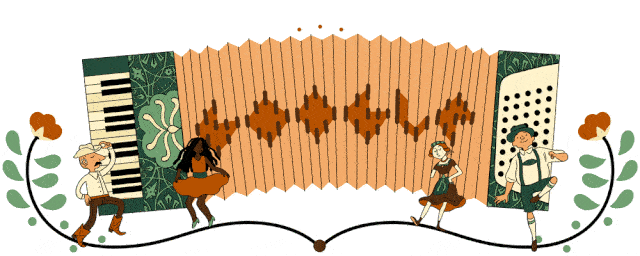Festivals & Events
Interesting and Fun Facts about the Accordion You Should Need to Know

The accordion, a free-reed instrument with bellows that has influenced pop, jazz, folk, and classical music genres, is the main focus of today’s Google animated Doodle. The accordion is the primary instrument of folk musicians, and this Google Doodle honors it. The bellows expand and contract, producing sound on the instrument. Since the accordion is a free-reed instrument, the sound is produced by airflow vibrating the reeds inside. The concertina, bandoneon, harmonium, and other free-reed instruments with bellows were among the many instruments that were invented in the early 1800s. The word accordion, which comes from the German word akkord (chord), was first used to patent an instrument on May 23, 1829.
40 Interesting and Fun Facts about the Accordion
- The name accordions derives from the German word for “musical chord, concord of sounds” (Akkord), which was used to describe the bellows-driven free-reed aerophone family of box-shaped musical instruments that made sound by passing air over a reed inside a frame in the 19th century.
- The fundamental characteristic of the accordion is its ability to integrate an accompaniment or basso continuo feature on the left-hand keyboard with a melody section, also known as the diskant, which is typically played on the right-hand keyboard.
- The melody is typically played on the right side (also called the keyboard or occasionally the manual) by the musician, while the accompaniment is typically played on the left side (usually on the bass or preset chord buttons).
- A person who performs accordion music is referred to as an accordionist.
- The family of free-reed aerophones includes the accordion.
This family of instruments also includes the bandoneon, harmonica, and concertina. - Although they belong to the same family as the harmonium and American reed organ, they differ in size and usually rest on a surface or the floor.
- Playing the accordion involves compressing or expanding the bellows while depressing buttons or keys, which opens pallets and lets air pass over reeds—strips of steel or brass—that are used as playing pieces.
- The waves of migration from Europe to the Americas and other regions have resulted in the accordion’s widespread distribution throughout the world.
- The basic design of the accordion is credited to Christian Friedrich Ludwig Buschmann, who is thought to have created it in Berlin in 1822, though an earlier instrument was found in 2006.
- The instrument was already widely used by the late 1840s; the two masters’ factories combined produced 10,000 instruments annually.
- Tula and its surrounding villages were producing more than 50,000 instruments annually by 1866, and by 1874, that number had risen to over 700,000.
- It is used in popular music in some countries (like Argentina, Brazil, Colombia, the Dominican Republic, Mexico, and Panama) (like chamamé in Argentina, gaucho, forró, and sertanejo in Brazil, vallenato in Colombia, merengue in the Dominican Republic, and norteño in Mexico), but it is more commonly used in dance-pop and folk music in other regions (like Europe, North America, and other South American countries).
- Some popular music acts from North America and Europe also use the instrument.
- The accordion is also used in solo and orchestral classical music performances, as well as in jazz, klezmer, Cajun, and zydeco music.
- San Francisco, California’s official city instrument is the piano accordion.
- The term harmonika, which translates to “harmonic, musical” from the Greek harmonikos, is the oldest name for this group of instruments.
- There are two types of accordions: diatonic and chromatic. When considering buying an accordion for sale, people are constantly searching for the ideal balance because it guarantees that the instrument will sound fantastic in both types of music.
- Diatonic accordions are ideal for playing traditional folk tunes because they are tuned to a specific key, typically C major or G major. Nevertheless, chromatic accordions, which have multiple rows of buttons and can be played in any key, provide more flexibility.
- The accordion’s versatility is what attracts people to it as an instrument. When someone asks you why your accordion has two sets of buttons, it’s also a great conversation starter. Furthermore, having diatonic and chromatic capabilities gives you more possibilities to produce complex and interesting sounds.
- The accordion has a really interesting and unique method of operation. The reeds on the instrument are connected to a bellows system, which produces sound when the musician pulls and pushes on the reeds. The musician presses buttons or keys to open valves that direct air over individual reeds to produce different notes.
- Some accordions also feature switches that let the player choose how many of the reed rows to use at any given time. This makes it possible to adjust the volume and softness of individual notes more effectively. An expert player can create extraordinarily complex melodic patterns with their instrument with practice!
- Around the world, the accordion has been incorporated into both traditional and modern music. It is common throughout Europe, but it can also be found in the US and Russia. The accordion is still used in many genres of music today and has become an essential part of traditional music styles in some countries.
- For example, the instrument is typically used for oompah and schlager music in Germany. On the other hand, button accordions are frequently heard in norteño music in Mexico. Serbia is another country that has embraced the accordion and frequently uses it for kolo music.
- It is a truly global instrument, having influenced many different cultures and genres. In addition, its versatility and ease of transportation have rendered it a desirable choice for musicians around the world.
- It’s clear that the accordion can be used in a variety of musical genres because it’s so widely used. The following areas show the most usage of it:
Folk
Jazz
Classical
Latin genres, such as Tejano and conjunto
Rockabilly
Blues
Country & Western - For hundreds of years, the accordion has been a part of many musical genres. It’s a very adaptable instrument that can give any kind of music a distinctive flavor! Because of this, the accordion will always have a special place in the annals of music.
- To meet your various demands, you can obtain a variety of accordions. Popular ones include the diatonic button accordion, which is frequently used in traditional folk music, the chromatic button accordion, which has notes from different rows of buttons, and the piano, which can play in a range of two to three octaves.
- Additionally, there is the concertina, which is available in various forms such as English system models and Anglo-German versions. It’s worth trying out every kind of instrument if you want to experiment with different musical genres or create unique soundscapes because they all produce different sounds!
- A single accordion is composed of more than a hundred parts. Its bellows, which have buttons to play different notes in addition to metal reeds, are undoubtedly the most important component. Other parts that aid in sound control include airtight valves and various switches. These elements combined are what give an accordion its distinctive and fascinating qualities!
- The way all those small details come together to create such a stunning instrument is simply astounding. Considering how well all of its complex components function, it is easy to understand why the accordion has been loved by many people for centuries after it was created.
- There was a period in music history when the accordion predominated. Known as the “Golden Age,” this period of time, which spanned the 1930s through the 1950s, was particularly well-liked in North America, Europe, and Canada.
- Around the world at this time, accordions were a common sight at festivals, dances, contests, and music events. Additionally, American performers such as Liberace, who incorporated it into their performances, saw a huge surge in popularity for it. A boom in the creation of new and vintage accordions occurred during this time, and jazz, rock ‘n’ roll, and country music were added to the repertoire.
- Acquiring proficiency in the accordion requires a significant investment of time and effort. To become a proficient accordion player, one must dedicate themselves to hours of practice, patience, and dedication. Reading sheet music and having a firm grasp of music theory are prerequisites for becoming really good at it.
- Furthermore, it can be challenging at first to learn how to use a button-based keyboard, but practice makes perfect. You can learn to play the accordion and create beautiful music with enough perseverance and hard work. Being difficult to learn is therefore a significant challenge that only great musicians accept if they hope to succeed.
- One of the most interesting instruments available is the accordion, which can be played in both diatonic and chromatic modes. It functions differently and has been employed historically in a variety of nations and genres.
- There are many different kinds of accordions, but they are all made up of hundreds of different parts. The instrument did indeed have a heyday in the early to mid-1900s, and mastering it is no easy task!
- The name accordion is more common in native versions these days. The accordion type patented by Cyrill Demian, which featured “automatically coupled chords on the bass side,” is referenced by these names.
- The instrument can now be heard in a variety of genres of music, including cajun, tango, Latino polka, and folk! Oktoberfest is one occasion where you can always find the accordion. Lederhosen, dirndl dresses, and other traditional clothing are all part of this exciting celebration that features music and carnival fun.
- Everything proceeds according to schedule when you have this melody maker! Two centuries later, the traditional sound still shapes German festivities and music worldwide.
- On May 23, 2024, Google featured an animated Doodle on its homepage to celebrate the Accordion.
-

 Business4 weeks ago
Business4 weeks agoHow to fill MSME Form 1? Step-by-Step Guide
-
Business4 weeks ago
From Marine to Chief: The Leadership Journey of Sean Mannix
-

 Gadget4 weeks ago
Gadget4 weeks agoAfter Grand Success on BLDC Ceiling Fan, Eff4 Is Launching Smart Bulb
-

 Festivals & Events4 weeks ago
Festivals & Events4 weeks agoGoogle Celebrates Cherry Blossom Season with Animated Doodle
-

 Business2 weeks ago
Business2 weeks agoPrakash and Kamal Hinduja: Driving Social and Environmental Change
-
Education3 weeks ago
Fred DuVal: University Leadership as a Critical Resource for Climate Change Research and Life-Saving Solutions
-

 Sports4 weeks ago
Sports4 weeks ago2025 NASCAR Craftsman Truck Series Baptist Health 200 at Homestead-Miami Speedway: Race Preview, Prediction, Schedule, Entry List, Drivers to Watch and How to Watch
-

 Health2 weeks ago
Health2 weeks agoThe Hinduja Brothers Commitment to Global Health: Empowering Communities Across Borders























